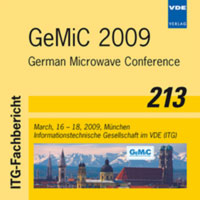A Comparison of two RF Vector-Sum Phase Shifter Concepts
Conference: GeMiC 2009 - German Microwave Conference
03/16/2009 - 03/18/2009 at München, Germany
Proceedings: GeMiC 2009
Pages: 5Language: englishTyp: PDF
Personal VDE Members are entitled to a 10% discount on this title
Authors:
Erkens, Holger; Wunderlich, v; Heinen, Stefan (RWTH Aachen University, Chair of Integrated Analog Circuits, Sommerfeldstr. 24, 52074 Aachen, Germany)
Abstract:
Two variants of a vector-sum phase shifter are presented in this paper. Vector-sum phase shifters can be built highly compact without excessive use of inductors and are therefore feasible for highly integrated, low-cost RFICs with a low demand on chip area. Both concepts vary in their vector generation and gain programming networks as the most critical aspects of the vector-sum approach as well as the chosen level of integration. Concept 1 is a semi-integrated device applying the predistorted output of a current steering digital-to-analog converter to an analog multiplier for programmable gain, using a differential off-chip LC network for quadrature summation. The fully integrated concept 2 employs a semi-digital multiplier cell driving a passive polyphase filter as the quadrature summing network. The given overview enables designers to fix the system aspects early in the design process, leaving more time to circuit level optimization. Both devices have been designed in a quarter micron SiGe BiCMOS technology for phased array applications in the S-band (2.9 GHz ... 3.1 GHz).


